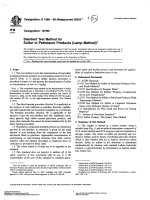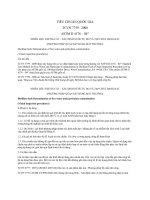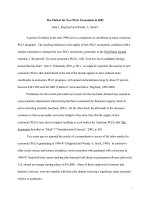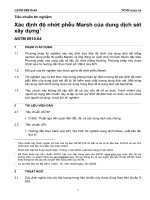Astm d 368 89 (2002)
Bạn đang xem bản rút gọn của tài liệu. Xem và tải ngay bản đầy đủ của tài liệu tại đây (27.71 KB, 2 trang )
American Association State
Highway Transportation Officials Standard
AASHTO No. T 86
Designation: D 368 – 89 (Reapproved 2002)
Standard Test Method for
Specific Gravity of Creosote and Oil-Type Preservatives1
This standard is issued under the fixed designation D 368; the number immediately following the designation indicates the year of
original adoption or, in the case of revision, the year of last revision. A number in parentheses indicates the year of last reapproval. A
superscript epsilon (e) indicates an editorial change since the last revision or reapproval.
4. Significance and Use
4.1 This is a test method to determine the specific gravity of
creosote and creosote-coal tar solutions for conformance to
Specifications D 390 and D 391. It may also be used with other
oil-type preservatives.
1. Scope
1.1 This test method covers the determination of the specific
gravity of oil-type preservatives by means of the hydrometer.
Test Methods D 38 covers the sampling of wood preservatives
prior to testing. To determine the specific gravity of distillation
fractions of such preservatives use Test Method D 369.
1.2 This standard does not purport to address all of the
safety concerns, if any, associated with its use. It is the
responsibility of the user of this standard to establish appropriate safety and health practices and determine the applicability of regulatory limitations prior to use.
5. Apparatus
5.1 Hydrometers—A set of three hydrometers covering the
range 1.000 to 1.150 and conforming to the requirements for
hydrometers 125H (range 1.000 to 1.050), 126H (range 1.050
to 1.100), and 127H (range 1.100 to 1.150) is prescribed in
Specification E 100. If not available, hydrometers (60/60°F) in
the range 1.000 to 1.150 of similar accuracy and having a scale
length not less than 9.5 mm/0.010 units of specific gravity, may
be used.
5.2 Hydrometer Cylinder—A glass cylinder having the
following approximate dimensions:
2. Referenced Documents
2.1 ASTM Standards:
D 38 Test Methods for Sampling Wood Preservatives Prior
to Testing2
D 347 Test Method for Volume and Specific Gravity Correction Tables for Creosote and Coal Tar2
D 369 Test Method for Specific Gravity of Creosote Fractions and Residue2
D 390 Specification for Coal-Tar Creosote for the Preservative Treatment of Piles, Poles, and Timbers for Marine,
Land, and Fresh Water Use2
D 391 Specification for Creosote-Coal Tar Solution2
E 1 Specification for ASTM Thermometers3
E 100 Specification for ASTM Hydrometers3
Length
Diameter
approximately 300 mm
not less than 32 mm
5.3 Thermometer—An ASTM Low Softening Point Thermometer having a range from −2 to 80°C (30 to 180°F),
conforming to the requirements for Thermometer 15C (15F) as
described in Specification E 1, or other thermometer of suitable
range and precision.
6. Procedure
6.1 Place the oil in the cylinder to a depth sufficient to float
the hydrometer, and with thorough stirring to ensure uniformity, adjust the temperature to 38°C (100°F), or if not entirely
liquid at that temperature, to the lowest temperature at which
the oil is completely liquid (Note 1). Insert the hydrometer and
allow the instrument to settle until it is in floating equilibrium.
Then read the height of the meniscus on the stem of the
hydrometer and the temperature to the nearest 0.1°C (0.2°F).
Add to the hydrometer reading an increment of specific gravity
equivalent to 1 mm on the scale. Then correct this observed
specific gravity at the observed temperature to the specific
gravity at 38/15.5°C using Table 2 of Test Method D 347.
3. Summary of Test Method
3.1 A hydrometer is floated in a totally liquid sample of the
preservative solution. The specific gravity is read at the
meniscus of the stem and corrected to the desired temperature.
1
This test method is under the jurisdiction of ASTM Committee D-7 on Wood
and is the direct responsibility of Subcommittee D07.06 on Treatments for Wood
Products.
Current edition approved Oct. 29, 1989. Published December 1989. Originally
published as D 368 – 33 T. Last previous edition D 368 – 84.
This test method is identical in substance with the Standard Method for the
Determination of the Specific Gravity of Oil-Type Preservatives which is part of the
American Wood-Preservers’ Association Standard Methods for Analysis of Creosote
and Oil-Type Preservatives (A1 – 62). Acknowledgment is made to the American
Wood-Preservers’ Association for its development of the subject matter covered in
this test method.
2
Annual Book of ASTM Standards, Vol 04.10.
3
Annual Book of ASTM Standards, Vol 14.03.
NOTE 1—It is advantageous to have the cylinder immersed in a bath
maintained at the temperature of test.
NOTE 2—See Table 1.
Copyright © ASTM International, 100 Barr Harbor Drive, PO Box C700, West Conshohocken, PA 19428-2959, United States.
1
D 368 – 89 (2002)
TABLE 1 Factors to Be Used for Determining the Specific Gravity at 60°F When Determined at Temperatures Ranging From 50 to
150°FA
Observed
Temperature, °F Group 0
50
51
52
53
54
55
56
57
58
59
60
61
62
63
64
65
66
67
68
69
70
71
72
73
74
75
0.9965
0.9968
0.9972
0.9975
0.9979
0.9982
0.9986
0.9990
0.9994
0.9997
1.0000
1.0003
1.0007
1.0010
1.0014
1.0018
1.0021
1.0024
1.0028
1.0031
1.0035
1.0038
1.0042
1.0045
1.0048
1.0052
Factors
Group 1
Group 2
0.9960
0.9964
0.9968
0.9972
0.9976
0.9980
0.9984
0.9988
0.9992
0.9996
1.0000
1.0004
1.0008
1.0012
1.0016
1.0020
1.0024
1.0028
1.0032
1.0036
1.0040
1.0044
1.0048
1.0052
1.0056
1.0060
0.9951
0.9956
0.9961
0.9965
0.9970
0.9975
0.9980
0.9985
0.9990
0.9995
1.0000
1.0005
1.0010
1.0015
1.0020
1.0025
1.0030
1.0035
1.0039
1.0044
1.0049
1.0054
1.0059
1.0065
1.0070
1.0075
Observed
Observed
Factors
TemperTemperature, °F Group 0 Group 1 Group 2 ature, °F
76
77
78
79
80
81
82
83
84
85
86
87
88
89
90
91
92
93
94
95
96
97
98
99
100
101
1.0056
1.0059
1.0063
1.0066
1.0069
1.0073
1.0077
1.0081
1.0084
1.0087
1.0091
1.0094
1.0098
1.0101
1.0105
1.0108
1.0112
1.0115
1.0119
1.0122
1.0126
1.0130
1.0133
1.0137
1.0140
1.0144
1.0064
1.0068
1.0072
1.0076
1.0080
1.0084
1.0088
1.0092
1.0096
1.0100
1.0104
1.0108
1.0112
1.0117
1.0121
1.0125
1.0129
1.0133
1.0137
1.0141
1.0145
1.0150
1.0154
1.0158
1.0162
1.0166
1.0080
1.0085
1.0090
1.0095
1.0100
1.0105
1.0110
1.0115
1.0120
1.0125
1.0130
1.0135
1.0140
1.0146
1.0151
1.0156
1.0161
1.0167
1.0171
1.0178
1.0182
1.0187
1.0192
1.0197
1.0202
1.0207
102
103
104
105
106
107
108
109
110
111
112
113
114
115
116
117
118
119
120
121
122
123
124
125
126
127
Factors
Group 0 Group 1 Group 2
1.0148
1.0152
1.0155
1.0159
1.0162
1.0166
1.0169
1.0173
1.0176
1.0180
1.0183
1.0187
1.0191
1.0195
1.0198
1.0202
1.0205
1.0209
1.0212
1.0216
1.0220
1.0223
1.0227
1.0230
1.0233
1.0237
1.0170
1.0173
1.0177
1.0182
1.0186
1.0190
1.0193
1.0197
1.0201
1.0206
1.0210
1.0214
1.0218
1.0222
1.0226
1.0231
1.0235
1.0239
1.0243
1.0247
1.0252
1.0255
1.0259
1.0263
1.0267
1.0272
1.0212
1.0219
1.0224
1.0229
1.0234
1.0240
1.0244
1.0249
1.0254
1.0259
1.0265
1.0270
1.0275
1.0280
1.0286
1.0291
1.0296
1.0300
1.0307
1.0312
1.0318
1.0323
1.0328
1.0334
1.0339
1.0344
Observed
Factors
Temperature, °F Group 0 Group 1 Group 2
128
129
130
131
132
133
134
135
136
137
138
139
140
141
142
143
144
145
146
147
148
149
150
...
...
...
1.0240
1.0244
1.0248
1.0251
1.0255
1.0258
1.0262
1.0266
1.0269
1.0272
1.0276
1.0280
1.0284
1.0288
1.0291
1.0294
1.0298
1.0302
1.0305
1.0308
1.0312
1.0316
1.0319
...
...
...
1.0276
1.0280
1.0284
1.0288
1.0292
1.0296
1.0300
1.0304
1.0309
1.0313
1.0316
1.0320
1.0325
1.0329
1.0333
1.0336
1.0341
1.0345
1.0349
1.0353
1.0358
1.0362
1.0366
...
...
...
1.0350
1.0355
1.0360
1.0366
1.0371
1.0377
1.0382
1.0387
1.0392
1.0398
1.0402
1.0408
1.0413
1.0418
1.0424
1.0430
1.0435
1.0440
1.0446
1.0451
1.0457
1.0462
1.0469
...
...
...
A
For petroleum oils and pentachlorophenol solutions to correct the specific gravity at the observed temperature to the basis of 60°F, multiply it by the factor in Table
1 at the corresponding temperature.
Group
0
1
2
Degrees
0 to 14.9
15 to 34.9
35 to 50.9
Specific Gravity at 60/60°F
1.0760 to 0.9665
0.9659 to 0.8504
0.8498 to 0.7758
7. Report
7.1 Report the specific gravity at 38/15.5°C to the nearest
one thousandth unit of specific gravity.
8.1.2 Reproducibility—The results submitted by two different laboratories should not be considered suspect unless the
reported results differ by more than 0.010.
8. Precision and Bias
8.1 The following criteria should be used for judging the
acceptability of results at the 95 % probability level:
8.1.1 Repeatability—Duplicate determinations by the same
operator should not be considered suspect unless the reported
results differ by more than 0.005.
9. Keywords
9.1 creosote; oil; preservative; specific gravity; wood
ASTM International takes no position respecting the validity of any patent rights asserted in connection with any item mentioned
in this standard. Users of this standard are expressly advised that determination of the validity of any such patent rights, and the risk
of infringement of such rights, are entirely their own responsibility.
This standard is subject to revision at any time by the responsible technical committee and must be reviewed every five years and
if not revised, either reapproved or withdrawn. Your comments are invited either for revision of this standard or for additional standards
and should be addressed to ASTM International Headquarters. Your comments will receive careful consideration at a meeting of the
responsible technical committee, which you may attend. If you feel that your comments have not received a fair hearing you should
make your views known to the ASTM Committee on Standards, at the address shown below.
This standard is copyrighted by ASTM International, 100 Barr Harbor Drive, PO Box C700, West Conshohocken, PA 19428-2959,
United States. Individual reprints (single or multiple copies) of this standard may be obtained by contacting ASTM at the above
address or at 610-832-9585 (phone), 610-832-9555 (fax), or (e-mail); or through the ASTM website
(www.astm.org).
2









